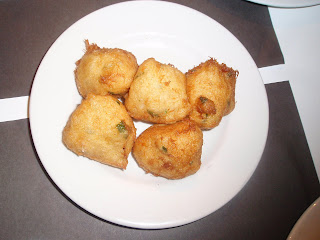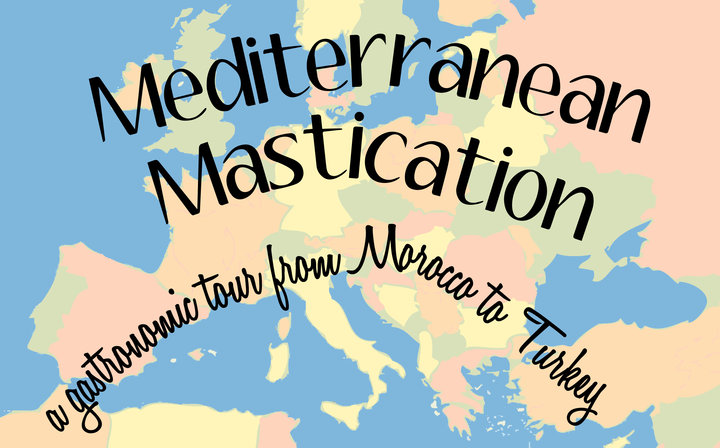In parts of Andalucia, when you go to a bar and order a drink, you will often get a tapa for free. Yes that's right free. Let's just say it was very pleasing for a backpackers budget and quite entertaining... what are they going to bring out next? I'm going to blame that concept on how much rosado we drank in those southern cities!
The serving of tapas is designed to encourage conversation because people are not so focused upon eating an entire meal that is set before them.
According to legend the tapas tradition began when king Alfonso X of Castile recovered from an illness by drinking wine with small dishes between meals. After regaining his health, the king ordered that taverns would not be allowed to serve wine to customers unless it was accompanied by a small snack or "tapa."
Other history suggests the original tapas were the slices of bread or meat which sherry drinkers in Andalusian (the southern province of Spain) taverns used to cover their glasses between sips. This was a practical measure meant to prevent fruit flies from hovering over the sweet sherry. The meat used to cover the sherry was normally ham or chorizo, which are both very salty and activate thirst. Because of this, bartenders and restaurant owners began creating a variety of snacks to serve with sherry, thus increasing their alcohol sales. The tapas eventually became as important as the sherry.
Tapas has evolved through Spanish history by incorporating ingredients and influences from many different cultures and countries. Most of the Iberian Peninsula was invaded by the Romans, who introduced the olive and irrigation methods. The invasion of the North African Moors in the 8th century brought almonds, citrus fruits and fragrant spices. The influence of their 700-year presence remains today, especially in Andalusia. The discovery of the New World brought the introduction of tomatoes, sweet and chili peppers, maize (corn), beans and potatoes. These were readily accepted and easily grown in Spain's microclimates.
In Spain dinner is usually served between 9pm and 11 p.m. (sometimes as late as 12 midnight), leaving significant time between work and dinner. Therefore, Spaniards often go "bar hopping" and eat tapas in the time between finishing work and having dinner. Since lunch is usually served between 1 and 3 p.m., another common time for tapas is weekend days around noon as a means of socializing before lunch proper at home.
It is very common for a bar or a small local restaurant to have 8 to 12 different kinds of tapas in warming trays with glass partitions covering the food. They are often very strongly flavored with garlic, chilies or paprika, cumin, salt, pepper, saffron and sometimes in plentiful amounts of olive oil.
There are 3 ingredients that are usually the starting point for most tapas;
SEAFOOD
Often one or more of the choices is seafood (mariscos), often including anchovies, sardines or mackerel in olive oil, squid or others in a tomato based sauce, sometimes with the addition of red or green peppers or other seasoning.
 Salted cod fritters (bacalo).
Salted cod fritters (bacalo). Whitebait.
Whitebait. Tuna empanada (flaky tuna pie).
Tuna empanada (flaky tuna pie). Andalusian style calamari.
Andalusian style calamari. Stuffed calamari ring (aka Eggfish!)
Stuffed calamari ring (aka Eggfish!) Mussels.
Mussels. Sardines & tomatoes on bread.
Sardines & tomatoes on bread.  Pescado frito (whole fried small fish).
Pescado frito (whole fried small fish). Fried fish bites.
Fried fish bites.JAMON
(including cured ham or other salted meats - primarily pork)
 Blue cheese sausages (Roquefort).
Blue cheese sausages (Roquefort). Homemade chorizo & potato pobo (similiar to potato bake).
Homemade chorizo & potato pobo (similiar to potato bake). Lamb Skewers (these really packed a punch - delish!).
Lamb Skewers (these really packed a punch - delish!). Jamon with bread (so simple but so great).
Jamon with bread (so simple but so great). Toasted jamon & queso sandwich with frites (basically ham & cheese toasted sanger with chips - great after a few drinks!).
Toasted jamon & queso sandwich with frites (basically ham & cheese toasted sanger with chips - great after a few drinks!).PATATES
(baked, fried, chips, mashed into croquettes - the Spanish love potatoes!)
 Potato & spinach croquettes.
Potato & spinach croquettes. Tortilla patates (potato & onion omlette).
Tortilla patates (potato & onion omlette). Patates fritas with sardines (literally potato chips with sardines mixed in).
Patates fritas with sardines (literally potato chips with sardines mixed in). Patatas bravas (balls of fried potato with mayo-like & chili sauces drizzled over).
Patatas bravas (balls of fried potato with mayo-like & chili sauces drizzled over). Potato salad with breadsticks.
Potato salad with breadsticks.It is rare to see a tapas selection not include one or more types of olives, such as manzanilla or arbequina olives.
 Marinated olives.
Marinated olives. Felafels with olives.
Felafels with olives.Phew, let's just I am a little rounder in the middle after all those tapas, and its only going to get worse! I am now sampling sensational Sicily for a week and then head up into Southern Italy to camp out around Naples (the HOME of pizza).
Cheers, CW x
NOTE: Special thanks to my fellow tapas tester Sophie, for whom without I could not have sampled such a wide variety of tasty treats!

No comments:
Post a Comment